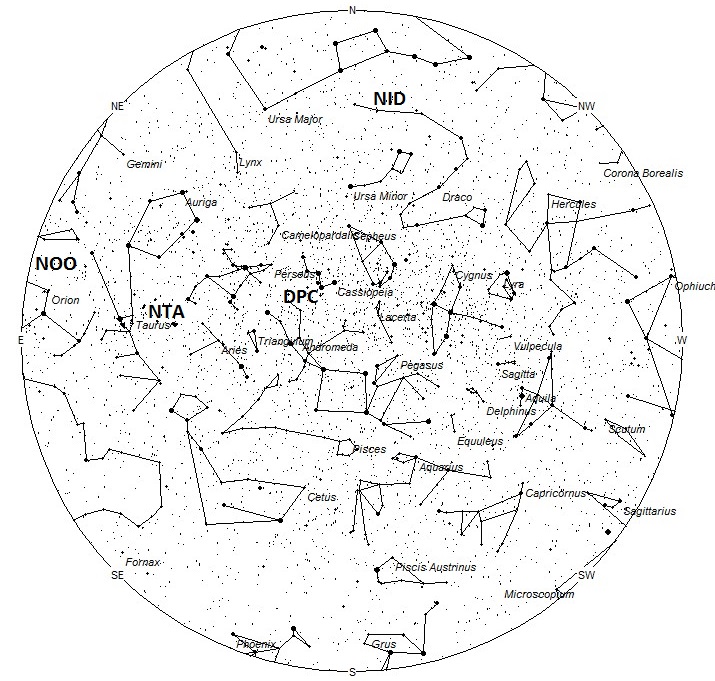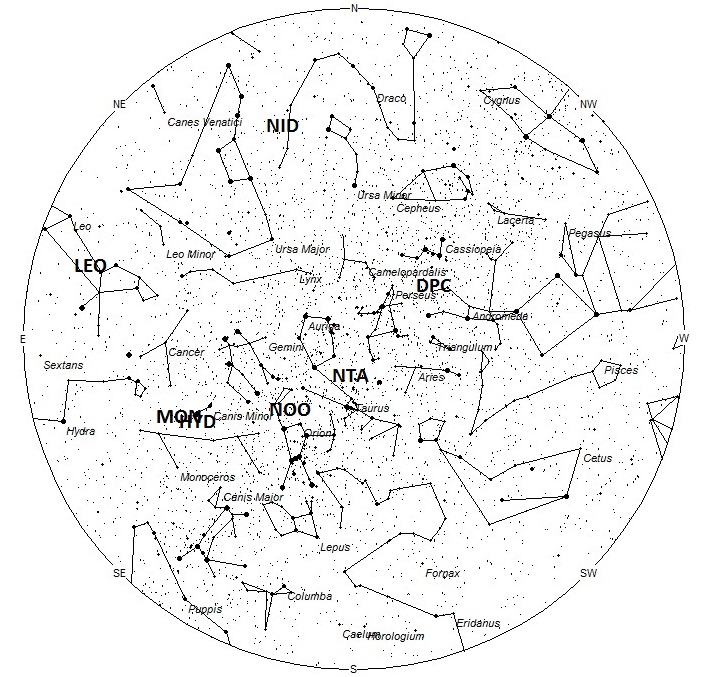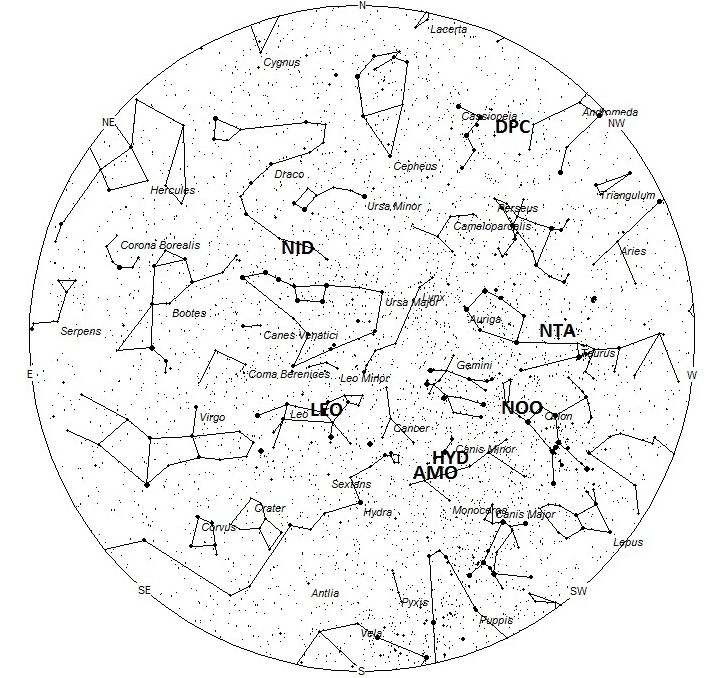During this period the moon reaches its last quarter phase on Monday November 25th. At this time the half-illuminated moon will lie 90 degrees west of the sun and will rise near midnight local standard time as seen from mid-northern latitudes. This weekend and Monday, the moon will interfere with morning observations. This can be overcome if you have transparent skies and you face away from the moon. The evening hours are free of moonlight but produce less activity than after midnight. As the week progresses, the waning crescent moon will rise later each night. By the end of the period it will not be much of a factor as it will be thin and will only rise just before the start of dawn. The estimated total hourly meteor rates for evening observers this week is near 4 for observers located in the northern hemisphere and 3 for those viewing south of the equator. For morning observers the estimated total hourly rates should be near 15 as seen from mid-northern latitudes and near 10 for observers viewing from tropical southern latitudes. Morning rates are lower than normal due to interfering moonlight. The actual rates will also depend on factors such as personal light and motion perception, local weather conditions, alertness and experience in watching meteor activity. Note that the hourly rates listed below are estimates as viewed from dark sky sites away from urban light sources. Observers viewing from urban areas will see less activity as only the brightest meteors will be visible from such locations.
The radiant (the area of the sky where meteors appear to shoot from) positions and rates listed below are exact for Saturday night/Sunday morning November 23/24. These positions do not change greatly day to day so the listed coordinates may be used during this entire period. Most star atlases (available at science stores and planetariums) will provide maps with grid lines of the celestial coordinates so that you may find out exactly where these positions are located in the sky. A planisphere or computer planetarium program is also useful in showing the sky at any time of night on any date of the year. Activity from each radiant is best seen when it is positioned highest in the sky, either due north or south along the meridian, depending on your latitude. It must be remembered that meteor activity is rarely seen at the radiant position. Rather they shoot outwards from the radiant so it is best to center your field of view so that the radiant lies at the edge and not the center. Viewing there will allow you to easily trace the path of each meteor back to the radiant (if it is a shower member) or in another direction if it is a sporadic. Meteor activity is not seen from radiants that are located below the horizon. The positions below are listed in a west to east manner in order of right ascension (celestial longitude). The positions listed first are located further west therefore are accessible earlier in the night while those listed further down the list rise later in the night.
The following sources of meteoric activity are expected to be active this week:
Late in this period a few meteors from the December Phi Cassiopeiids (DPC) may be seen. These meteors were discovered by Peter Jenniskens and are active from November 26 through December 5th. Maximum activity occurs on December 1st when the radiant is located at 01:33 (023) +53. This area of the sky is located in southern Cassiopeia, 3 degrees southeast of the faint star known as Theta Cassiopeiae.
The Northern Taurids (NTA) are active from a large radiant centered at 04:36 (069) +24, which lies in central Taurus, 8 degrees north of the 1st magnitude orange star known as Aldebaran (Alpha Tauri). The radiant is best placed near 0100 LST, when it lies highest above the horizon. Rates should be near 2 per hour as seen from the northern hemisphere and 1 as seen from south of the equator
The November Orionids (NOO) are active from a radiant currently located at 05:48 (087) +15, which lies in on the Taurus/Orion border, 8 degrees north of the bright orange star known as Betelgeuse (Alpha Orionis). These meteors are best seen near 0200 LST when the radiant lies highest above the horizon. Current rates should be near 2 per hour no matter your location. With an entry velocity of 44 km/sec., most activity from this radiant would be of medium speed.
Late in this period the first members of the Sigma Hydrids (HYD) may be seen. This shower is active from November 26 through December 21, with maximum activity occurring on December 6. The radiant is currently located at 07:36 (114) +05, which places it in central Canis Minor, just 1 degree southwest of the brilliant zero magnitude star known as Procyon (Alpha Canis Minoris). These meteors are best seen near 0400 LST when the radiant lies highest above the horizon. Current rates should be less than 1 per hour no matter your location. With an entry velocity of 62 km/sec., most activity from this radiant would be of swift speed.
The last of the Alpha Monocerotids (AMO) may be seen this weekend from a radiant located at 08:00 (120) +01. This position lies in eastern Canis Minor, 5 degrees southeast of the brilliant zero magnitude star known as Procyon (Alpha Canis Minoris). These meteors are best seen near 0400 LST when the radiant lies highest above the horizon. Current rates should be less than 1 per hour no matter your location. With an entry velocity of 65 km/sec., most activity from this radiant would be of swift speed.
The Leonids (LEO) are still active from a radiant located at 10:32 (158) +20. This position is located in central Leo, 2 degrees east of the 3rd magnitude star known as Algeiba (Gamma Leonis). This area of the sky is best placed in the sky during the last hour before dawn, when it lies highest above the horizon in a dark sky. Current hourly rates should be near 3 as seen from the northern hemisphere and 2 as seen from south of the equator. With an entry velocity of 71 km/sec., most activity from this radiant would be of swift speed.
Studies of the Canadian Meteor Orbit Radar by Peter Brown has revealed an active radiant in Draco this time of year. The November Iota Draconids (NID) are active from November 22 through December 1, with maximum activity occurring on November 26. At maximum the radiant is located at 12:44 (191) +67. This area of the sky lies in western Draco, 3 degrees southeast of the fourth magnitude star Kappa Draconis. The radiant is best placed near 0100 LST, when it lies highest above the horizon. Current rates would be less than one shower member per hour, no matter your location. Due to the high northerly declination of the radiant these meteors are not visible from most of the southern hemisphere. Only southern equatorial regions would have any chance of seeing activity from this source. Meteors from the November Iota Draconids strike the atmosphere at 43km/sec., which would produce meteors of medium velocity.
As seen from the mid-northern hemisphere (45N) one would expect to see approximately 8 sporadic meteors per hour during the last hour before dawn as seen from rural observing sites. Evening rates would be near 3 per hour. As seen from the tropical southern latitudes (25S), morning rates would be near 4 per hour as seen from rural observing sites and 2 per hour during the evening hours. Locations between these two extremes would see activity between the listed figures. Morning rates are reduced due to moonlight.
The table below presents a list of radiants that are expected to be active this week. Rates and positions are exact for Saturday night/Sunday morning except where noted in the shower descriptions.
| SHOWER | DATE OF MAXIMUM ACTIVITY | CELESTIAL POSITION | ENTRY VELOCITY | CULMINATION | HOURLY RATE | CLASS |
| RA (RA in Deg.) DEC | Km/Sec | Local Standard Time | North-South | |||
| December Phi Cassiopeiids (DPC) | Dec 05 | 01:33 (023) +53 | 19 | 22:00 | <1 – <1 | IV |
| Northern Taurids (NTA) | Nov 11 | 04:36 (069) +24 | 29 | 01:00 | 2 – 1 | II |
| Nov. Orionids (NOO) | Nov 29 | 05:48 (087) +15 | 44 | 02:00 | 2 – 2 | II |
| Sigma Hydrids (HYD) | Dec 06 | 07:36 (114) +05 | 62 | 04:00 | <1 – <1 | II |
| Alpha Monocerotids (AMO) | Nov 21 | 08:00 (120) +01 | 65 | 04:00 | <1 – <1 | III |
| Leonids (LEO) | Nov 18 | 10:32 (158) +20 | 71 | 07:00 | 3 – 2 | I |
| Nov. Iota Draconids (NID) | Nov 26 | 12:44 (191) +67 | 43 | 09:00 | <1 – <1 | I |
 American Meteor Society
American Meteor Society



2 meteors breaking up in the west sky at 5:20pm cst to the west of Sioux
Falls, SD. at 10 o’clock in the sky. Large bright long tail